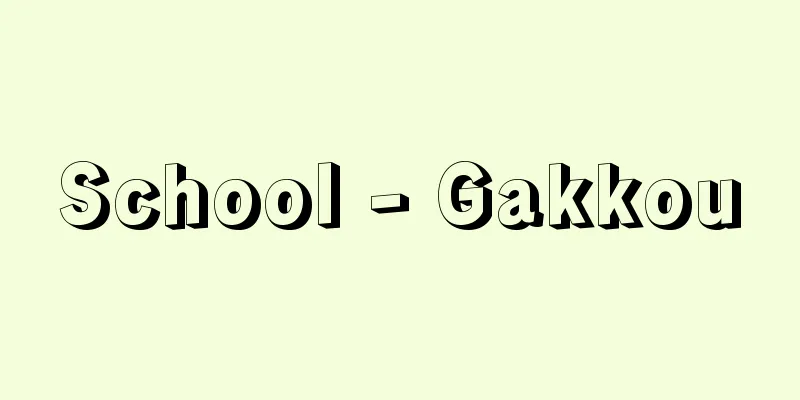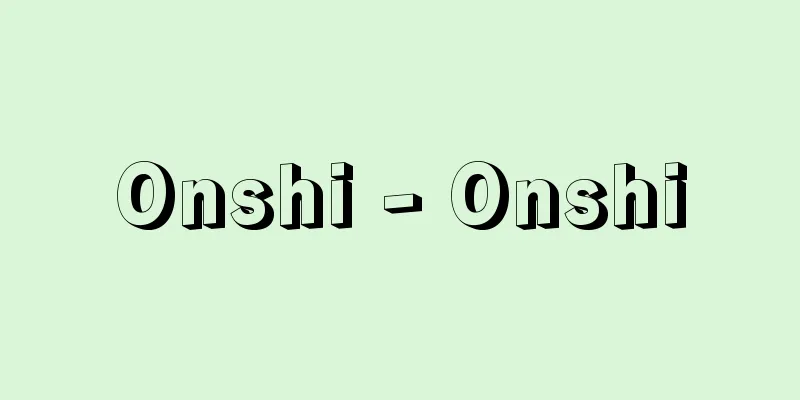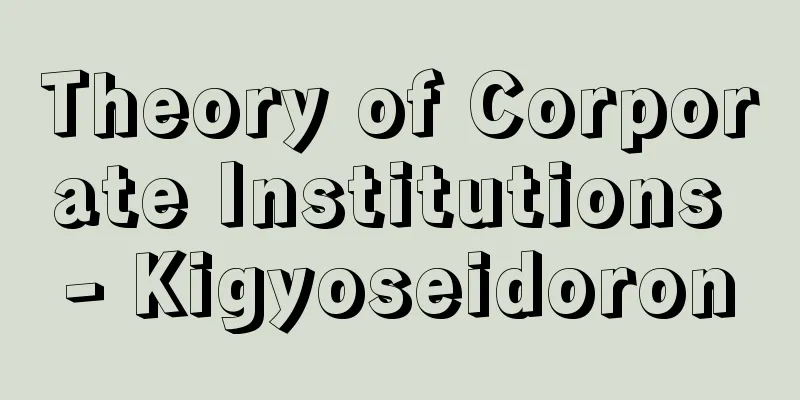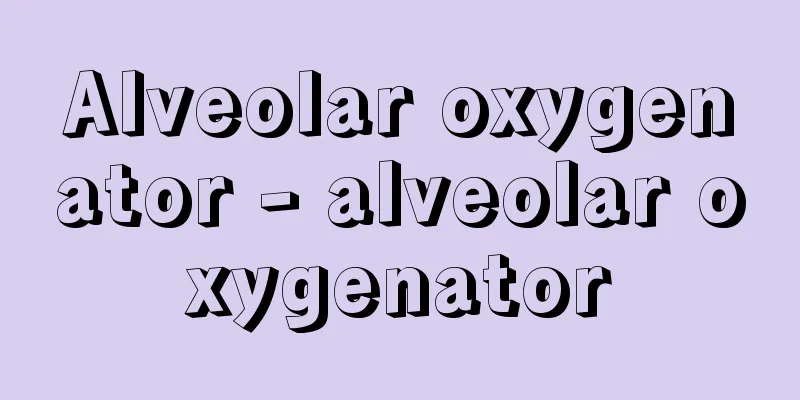School - Gakkou

|
An organization that carries out educational activities continuously and planned to achieve a certain educational goal, and is composed mainly of educators, students, and facilities necessary for educational activities. Education is something that is always present in all human activities, and has continued uninterruptedly since humans began living in society to the present day. Through the transition of social life, such education has gradually progressed from a stage where human development was directly and indirectly carried out unintentionally in some direction to a stage where it includes intentional development carried out with a certain purpose and form. In order to achieve a certain educational goal, a place where a certain period of continuous, comprehensive education is required. In order to realize the educational goal more efficiently and rationally, such a place needs a well-organized teaching organization and learning plan, and appropriate facilities and equipment are prepared. Some of these, like the Terakoya schools seen in Japan during the Edo period, have a single teacher who teaches basic reading and writing, while others, like today's schools, provide long-term, planned education under a large organization with many teachers and children and students. The facilities range from a small corner of a barracks to large school buildings with excellent facilities. When the enterprise of education is recognized as being widely useful to society, its implementation gradually becomes a social practice and is established. Furthermore, as society develops, and more organized and systematic education becomes necessary, the state will enact the necessary laws and attempt to establish and operate educational institutions. Such educational facilities are the schools that exist around us today. In the process of school development, when a single school alone is no longer able to meet the diverse educational needs of society, schools with different educational objectives are combined into various systems and stages to form a single school system. [Manomiya Yu] Origin and establishment of the schoolSchools have come into existence out of various needs that have arisen as a result of changes in human social life. [Manomiya Yu] Group life and educational organizationIn primitive societies, humans learned how to obtain food, build shelters, raise and cultivate animals and plants, and how to strengthen their bodies, and passed on this knowledge and skills to generations through their families and social groups. This was done unintentionally on a daily basis in family and social life. However, as group life developed, the stability of the group became the stability of their own lives, and each member had to do their best to protect their group life. Therefore, in social groups, members of the group demand certain qualities and abilities from each other, both to maintain order within the group and to defend against attacks from other groups. Thus, an educational custom called the initiation ceremony was born, where children in the group, especially when they become adults, receive training and approval to become official members of the group. This custom was performed by the elders on the young members of the group, and the objectives were (1) to develop a strong and healthy body so that they could fully serve as members of the group, (2) to acquire the traditional knowledge of the group and participate in the group's religious ceremonies, (3) to become aware of their own position within the group and to develop absolute loyalty to the group, and (4) to acquire sufficient fighting ability to defend the group against external enemies. This is said to be the oldest practice seen as a planned group education organization born out of the need to maintain human group life. Originally, the initiation ceremony was performed for all members of the group, but as the hierarchy of rulers and ruled developed in social groups, it shifted to an educational organization for only certain classes. Typical examples of this can be seen in city-states such as Sparta in ancient Greece and early Athens. Educational organizations born out of the necessity of collective living can also be found in Japan. A typical example is the Youth Group (or Youth Shu, Wakashu Ren, etc.) formed by the young people of a village in the Edo period. Young people in a village were obligated to join the Youth Group when they reached a certain age, and they had social functions such as playing leading roles in village festivals and entertainment events, and engaging in security and collective labor within the village. At the same time, through their collective life in the Youth Group, the young people naturally deepened their understanding of village life and acquired the productive skills necessary for collective village life, thereby forming the personality and developing the abilities appropriate for village members. Subsequent schools for national education in modern nations can also be seen to have similar intentions and content as large-scale mass educational organizations. [Manomiya Yu] Religious Life and SchoolDeepening one's faith is important in one's spiritual life. Christian education activities had been carried out since late antiquity in Europe, but in the Middle Ages, they expanded systematically with the development of the church system in various parts of Europe. For this purpose, each temple or monastery first established a school for the purpose of training monks, and then they also tried to establish church-affiliated schools for the purpose of educating believers. After the Protestant Reformation, in order to spread the faith life of the new sects to the general public, there was an increasing demand to strengthen religious education for all children through schools. However, the organization of schools for religious education required a powerful driving force behind it. As a result, the church and secular power were united, and eventually, with the establishment of the state, religious education tended to be used by the state as ideological education for the state or as part of a poverty relief policy. [Manomiya Yu] Liberal Arts and SchoolsAs social classes became more differentiated, the rulers and aristocracy came to live off the labor of slaves and peasants, and sought to acquire the education necessary to live the daily life of an aristocrat or to display their social status. In the late Athenian period, aristocrats used the leisure time (from the Greek word skholē meaning leisure, which evolved into time to acquire education during leisure time, and further to a place to acquire education, which became the origin of the word school) created by the labor of slaves to attend schools established throughout Athens and indulge in enriching their aristocratic education. Education for the education of aristocrats was passed down to church schools and court schools after the Middle Ages, and during the Renaissance, classical language schools that provided humanistic education in ancient Latin and Greek were established throughout Europe, aiming for a holistic and harmonious education. The contents were gradually organized into the seven liveral arts, including grammar, rhetoric, logic (dialectics), arithmetic, geometry, astronomy, and music, and sometimes religious education and physical education were also added. However, after the 16th century, only the formal aspects of classical language education were passed down as a form of education to enhance the status of the upper classes. [Manomiya Yu] Economic life and schoolAs commerce and industry gradually became more active from the agricultural era, various changes occurred in the social life of the general public. For small and medium-sized merchants and craftsmen in particular, the ability to read and write everyday language and calculate became indispensable tools in life. In the commercial cities of Europe from the early modern period onwards, public schools and private schools were established to teach the 3R's (reading, writing, and arithmetic, which were called reading, writing, and abacus in Japan). Terakoya schools in Japan during the Edo period also had a similar background. On the other hand, vocational training in commerce and industry was mostly dependent on the apprenticeship system at first, but disappeared with the development of the capitalist economy and was replaced by organized vocational education in vocational schools. In this way, the emergence of organizations for the education of the 3R's or vocational training was largely due to changes in daily life caused by the development of the economic life of the general public. However, unlike the upper class, they were hardly able to widely organize the education they needed by themselves. Therefore, after the establishment of modern nation-states, it was incorporated into the national education system through the power of the state. [Manomiya Yu] Development into a modern educational organizationAs social life developed, schools that clearly defined their educational objectives, target audience, content, and levels developed, and eventually in Europe and other places, these came to form a school system that combined two systems of school education. [Manomiya Yu] Lower-class school systemIn the 12th and 13th centuries, there was a growing demand for new professions such as judges, lawyers, doctors, and clergymen in Europe. As a result, many young people from all over Western Europe at that time gathered at famous scholars' schools to learn advanced specialized academic subjects such as law, medicine, and theology, and eventually school towns (studiums in Latin) were formed around them. In order to protect their status and interests, they formed student guilds (universitas in Latin), modeled after the merchant and craftsman guilds of the time, and tried to obtain official recognition by letters charter from the pope or king to obtain their privileges. This is said to be the origin of medieval universities in Europe, and the oldest are said to be in Bologna, Salerno, Paris, and Oxford. The establishment of such medieval universities showed the prototype of university autonomy in later generations, and many of them still exist as traditional universities in various countries today. However, the liberal nature that was evident at the time the university was first founded was eventually restricted or distorted by the protection and interference of the church and the state, and academic research centered on classical languages became increasingly conservative and aristocratic in character, and the university gradually came to serve only the formal aristocratic education. On the other hand, due to the influence of the Renaissance, schools for liberal arts education, mainly focusing on the classics, either became independent from church schools or were newly established. These classical language schools formed the basis of the major traditional secondary schools in Europe today, such as grammar schools and public schools in England, and Gymnasiums (German) in Germany. However, as universities became more conservative and aristocratic, universities began to require graduates of these classical language schools as admission qualifications, and classical language schools gradually became secondary schools connected to universities at a lower level, losing their original independent status and playing the role mainly of preparatory schools for universities. Here, educational organizations that aimed to provide liberal arts education mainly to the children of the aristocracy established a school system of "university → secondary school". Moreover, secondary schools gradually extended the grades to lower levels due to the need to prepare for university admission. Therefore, from the viewpoint of how it developed, this school system has the characteristic of being constructed "from the top down" with the university as the highest educational institution, and is therefore called a lower-level school system. In addition, this school system is also called a liberal arts school system from the original purpose of its establishment, an aristocratic school system from the subject of education, and a secondary school system because it is based on secondary schools. Thus, the privileged school system for liberal arts education, from secondary school to university, later added modern subjects to its curriculum and expanded its educational target to include the emerging classes, responding to their demands to get closer to the upper classes, but it continued to play the role of nurturing the social elite. [Manomiya Yu] Upper-level school systemFor a long time, schools for the common people were left incomplete and poor. In the end, the development and organization of these schools had to depend almost entirely on the expansion of social or educational policies promoted by the church or the state. In Europe, before schools were targeted by national policies, they were often left to the educational outreach of religious or private organizations. In the 19th century, modern nations finally strengthened state involvement in the organization of primary education and even established compulsory education by law in order to expand national education. The primary education systems established in this way were extended to higher levels with the development of the grade system, and the educational content began to include not only basic reading and writing, but also vocational and vocational education. In particular, the influence of industrial competition that arose between capitalist countries after the end of the 19th century was reflected in the promotion of industrial education in each country, leading to the expansion of vocational schools to train a large number of lower-level technicians. In modern nations, through educational policies aimed at strengthening national education and promoting vocational education for the children of the common people, a school system was gradually formed that was constructed in a "bottom-up" order, such as "elementary school → supplementary school or vocational school." This school system is called the top-down school system because of the way it developed, and can also be called the vocational school system because it was originally developed to impart knowledge and vocational skills useful for the daily lives of the common people, especially their economic lives. It is also called the common people's school system because of the subjects of education, and the elementary school system because of the type of school it was based on. For a while, this school system developed in parallel with the bottom-up school system that had already been established. [Manomiya Yu] Dual and single track school systemsIt was especially in the late 19th and 20th centuries in European countries that the establishment of the lower-class and upper-class school systems led to the separation of the two school systems. This was due to the long history of the two classes of nobility and commoners in European countries. However, in America, where class differentiation is not as clear as in Europe and its history is short, the two school systems were not so clear, and various schools were included in almost a single school system. Therefore, rather than differentiating educational objectives and content according to the differences in school systems as in Europe, American schools were divided into different school stages based on the educational level of elementary, middle, and high school, and education was provided according to each stage. In the school system that developed in Europe, multiple school systems were parallel and rarely crossed. In other words, the school system that a person should enter and the path they should follow were determined separately from the beginning according to their social status and position, and they were only educated at schools belonging to that school system, regardless of their abilities or wishes, and they were rarely able to advance to schools in other systems. In contrast, in the case of America, there is a single school system, so there are hardly any restrictions based on social status or position when it comes to advancing to higher-level schools or the path they follow after graduation. In this way, the school systems in Europe and America are completely opposite, with the former being called a dual-track school system and the latter a single-track school system. Furthermore, with these two school systems as the two poles, there is a branching school system in between. [Manomiya Yu] Equal educational opportunities and school system reformThe idea of individual freedom and equality began to take root as a result of events such as the French Civil Revolution and the American Revolution. This eventually led to demands for equal educational opportunities, and school system reforms were implemented to achieve this goal. The historical background to this is the development of modern public education in the 19th century. [Manomiya Yu] The development of modern public educationIn modern nations, in order to establish a new civil society, not only individual freedom and equality but also the responsibility of citizens to receive education came to be required. Receiving education was no longer just an individual benefit, but was considered to have a public nature as a citizen's responsibility. Moves to establish public schools to widely disseminate education to citizens were seen mainly in the 19th century in the United States. On the other hand, many social problems emerged, such as the emergence of a large number of young workers due to the development of factory industry. In order to protect children from such situations where they could not receive an education, countries gradually began to establish compulsory education. In addition, in order to reduce the economic burden on individuals who received education, free education was also adopted, and free tuition and textbooks were also introduced. Furthermore, the idea that the content of education received at school should be free of religious and political coercion so that it would contribute to the future happiness and benefit of the learners themselves spread, and an increasing number of countries began to establish religious and political neutrality in education. In this way, schools that would realize modern public education had already begun to be established in the second half of the 19th century, but without reform of the school system that created unequal educational opportunities, it would not be a fundamental solution. [Manomiya Yu] Equal educational opportunitiesIn Europe, in order to equalize opportunities for education, it was necessary to reform the dual-track school system and allow everyone to receive secondary education beyond primary education, and even higher education. This was embodied in the movement for a unified school (Einheitsschule in German, école unique in French) that developed in Germany from the end of the 19th century and in France during World War I, as well as the movement to open secondary schools in Britain after World War I. These movements aimed to give all citizens the same primary education in the same school, and to open up the opportunity for each person to receive education thereafter according to their abilities and wishes. To this end, the immediate goal of reform was to establish a branched school system that would unify the first four to six years of education in the dual-track school system into a single primary school. As a result, the path to secondary school was finally made wider in Germany with the Constitution of the Weimar Republic (1919) after World War I, in France with the Berthoin reforms (French: Réforme Berthoin) after World War II, and in the UK with the Education Act of 1944. Meanwhile, in the United States, a single-track school system centered on the 8-4 system had already been established in the latter half of the 19th century. However, in reality, problems arose, such as an increase in dropouts during the 8 years of primary education, and a decline in the academic ability of those who went on to college during the 4 years of secondary education. This led to a series of movements to reform secondary education, and first, a plan to reform to a 6-6 system aimed at expanding secondary education in order to raise the academic ability of those who went on to college began to be advocated. However, in the 20th century, there was a new momentum to increase the number of students moving on from primary education to secondary education, and there were also movements to establish three-year junior high schools. Furthermore, the report of the Committee on Secondary Education Reform established within the National Education Association (NEA) (1918) advocated the 6-3-3 system as a system that would enrich and expand secondary education and be advantageous for choosing and deciding on future career paths, and recommended its adoption to each state. In this way, America, which has a single-track school system, tried to open up opportunities to receive secondary and higher education by changing the division of school levels, rather than integrating school systems as in European countries. In this way, the movement to equalize educational opportunities in each country has developed various school system reforms, based on the historical and social conditions of each country, and these have been inherited from the end of World War II to the present day. [Manomiya Yu] The current situation and issues facing schools in JapanAfter the Second World War, Japan established a school system based on a single-track school system of 6-3-3-4 years with the aim of realizing equal educational opportunities. However, many issues remain to be addressed in order to meet the demands of modern society. [Manomiya Yu] Schools in our countrySchools can be broadly classified as follows: [1] Legal schools (a) Schools under the School Education Law (i) Article 1 schools These are schools that fall under the category of "schools prescribed by law" in the Fundamental Law of Education, and include the following 10 types: elementary school (general elementary education), junior high school (general secondary education), senior high school (higher general education and specialized education), secondary education schools (general secondary education, higher general education and specialized education), universities (teaching broad knowledge, teaching and research in specialized arts and sciences, developing intellectual, moral and applied abilities), colleges of technology (teaching specialized arts and sciences and cultivating abilities necessary for a career), schools for the blind, schools for the deaf and schools for the disabled (education equivalent to kindergartens, elementary schools, junior high schools or senior high schools, teaching knowledge and skills necessary to compensate for disabilities), and kindergartens (childcare). The Open University of Japan is a type of university listed in Article 1. (b) Other schools Educational facilities other than those listed in Article 1 include technical colleges (which aim to develop the abilities necessary for careers or real life, or to improve cultural literacy) and miscellaneous schools (which provide education similar to school education). (b) Schools under other laws These are schools under the jurisdiction of various ministries and agencies or belong to independent administrative institutions, and include vocational training schools, nurseries, child independence support facilities, the National Defense Academy of Japan, the Fisheries University, the Maritime University, the Nautical Training Institute, the Seafarers School, and the Air Force University. In addition, some educational activities covered by the Social Education Law have been organized and are called schools or have similar names. [2] Non-legal schools: These include various educational organizations established by companies or various groups, as well as various unlicensed cram schools. [Manomiya Yu] School assignmentsAfter the Second World War, educational reforms in many countries extended the number of years of compulsory education, opened and reformed the secondary and higher education systems, and improved and expanded the preschool and primary education systems, all of which played an important role in realizing equal educational opportunities and promoting and developing the abilities and aptitudes of individuals. However, in order to respond to today's era of social and industrial change, the specific content of school education as well as its limitations are being questioned anew. Modern education is increasingly required to respond to the developmental process of each individual, and schools are expected to provide children with even greater possibilities for development while responding to all kinds of social changes in their future social lives. Moreover, in modern society, with the rapid development of science and technology and the increase in the average lifespan of humans, education has come to have an increasingly significant impact on people's social lives throughout their lives. For this reason, people are expected to continue to grow and develop throughout their lives, both in their professional and cultural lives. Naturally, traditional school education for a set period of time is no longer sufficient, and the issue of lifelong education has been taken up by UNESCO (United Nations Educational, Scientific and Cultural Organization) since the mid-1960s, and concrete measures are being taken to address it. Since the 1970s, various proposals have been made on the future of schools, along with the trend towards "humanization of education," which seeks education rich in humanity for the life of humans. In Japan, too, with the aim of realizing "education with a view to the 21st century," a wide range of educational reforms are underway based on the recommendations of the Provisional Council on Education (1984-87) and the Central Council for Education of the Ministry of Education, Culture, Sports, Science and Technology. In particular, based on the educational philosophy of cultivating "life skills" in children in an "easy-going" environment, the government is aiming to carefully select the content of school education and to enrich education in the home and local community. In April 2002, a five-day school week was implemented in public schools, in an effort to improve and enrich school education in response to today's international and social situations. In addition, the government is also making efforts to reform the system, such as improving the selection of students for university and high school admissions, introducing integrated junior and senior high school education, and introducing educational exceptions such as exceptions to the age of university admission. In order to realize such educational reforms, it will be necessary to make the organizational structure of schools more flexible, to ensure continuity between levels of education, and to forge closer ties with families and the local community. [Manomiya Yu] Edited by Ito Hideo and Manomiya O, Issues in the Educational System (1975, Daiichi Hoki Publishing) ▽ Edited by Kono Shigeo, Lectures on Modern Education 3: Modern Schools (1975, Daiichi Hoki Publishing) ▽ Edited by Yoshimoto Jiro, Collected Works of Educational Studies 7: School Organization Theory (1976, Daiichi Hoki Publishing) ▽ Edited by Manomiya O, Modern Educational Systems (1977, Daiichi Hoki Publishing) ▽ Edited by Okihara Yutaka, Manomiya O, and Fujiwara Hideo, Lectures on Educational Administration 2: Educational Systems and Educational Administration (1978, Kyodo Publishing) ▽ Edited by Tsuji Isao and Kinoshita Shigeya, Lectures on Education 20: Expansion of Educational Opportunities (1979, Gakken) ▽ Edited by Manomiya O and Kuwahara Toshiaki, Right to Education and the Educational System (1988, Daiichi Hoki Publishing) ▽ Edited by Yoshimoto Jiro and Park Seung-woo, Schools (Lectures) "School Studies 1)" (1988, Daiichi Hoki Publishing)" ▽ "Theory of Lifelong Learning Systems" edited by Manomiya Yu (1991, Tokyo Shoseki)" ▽ "Educational System Research Group edited, "Outline of the Educational System" (1991, Academic Press)" ▽ "120-Year History of the Educational System" edited by the Ministry of Education (1992, Gyosei) " ▽ "School Education in Multicultural Communities - From Primary Schools in Canada" by Makino Atsushi (1999, Academic Press)" ▽ "Examples of Problems Surrounding the Realization of School Education Reform" edited by Shimomura Tetsuo and Somedaya Kenso (2000, Gakuyo Shobo)" [Reference items] | | | | | | | | | | | | Liberal arts | | education | | | | | | | | | | | | |Source: Shogakukan Encyclopedia Nipponica About Encyclopedia Nipponica Information | Legend |
|
一定の教育目的を達成するために、継続的、計画的に教育活動の営まれる組織であり、教育をする者、教育を受ける者、および教育活動に必要な施設設備を中心に構成される。教育は、もともと人間のあらゆる生活活動のなかにいつも存在するものであり、人間が社会生活を始めて以来、今日に至るまで連綿と継続してきたものである。そのような教育は、社会生活の変遷を通じて、直接に間接になんらかの方向に無意図的に人間形成が行われてきた段階から、しだいに一定の目的と形式のもとに営まれる意図的な形成作用を含むような段階にまで到達するようになった。なんらかの教育目的を達成するためには、一定の期間に、継続的にまとまった教育の行われる場を必要とする。その場は、教育目的がより能率的合理的に実現できるように、整った教授組織や学習計画をもち、それに見合った施設や設備が用意される。そのなかには、わが国の江戸時代にみられた寺子屋のように、お師匠さん1人で簡単な読み書きを教えるものもあれば、今日の学校のように多数の教員と児童・生徒等を擁する大規模な組織のもとに、長期にわたって計画的な教育を行うものもある。施設においても、小さなバラックの一隅を借りたものから、広大な校舎と優れた設備を完備するものまである。 教育という事業が社会的に広く有用であると認められるようになれば、それが営まれることはしだいに社会的な慣行となって定着する。さらに社会の発展に伴い、より組織的体系的な教育が要求されるようになると、国家はそれに必要な法律を制定して、教育機関の設置や運営を図ろうとする。そのような教育の場が、現在われわれの周辺に存在する学校である。学校の発達する過程において、一つの学校だけでは社会の多様な教育要求を満たすことができなくなると、さまざまな教育目的をもつ学校が、さまざまな系統や段階に組み合わされて一つの学校体系を構成する。 [真野宮雄] 学校の起源と成立学校は、人間の社会生活の変遷に伴う、さまざまな必要から成立してきた。 [真野宮雄] 集団生活と教育組織原始社会の人間は、食物を獲得したり、住居をつくったり、動植物を飼育栽培したりすることや、そのために必要な身体を強健にすべきことなどを自ら覚えたり、家族や社会集団を通して、その知識や技術を代々伝達するようになった。このような伝達は、家庭生活や社会生活のなかで、日常的に無意図的に行われていたものである。ところが、集団生活の発達とともに、彼らにとっては集団の安定を図ることが自分たちの生活の安定につながるようになるので、それぞれのメンバーは、自分たちの集団生活を守るために尽くさなければならなくなる。そのため、社会集団では、内では集団における秩序の維持を、外に向かっては他の集団からの攻撃に対する防衛のために、集団のメンバー同士が互いに一定の資質や能力をもつことを要求しあう。そこで、とくに集団内の子供たちが大人になるときに、その集団における正式の一員となるための訓練および承認を受ける場として、入社式とよばれる一つの教育的習俗を生ずるのである。 この習俗は、長老たちの手によってその集団の若者たちに施されるもので、その目的は、(1)集団の成員として十分に奉仕できるような強健な身体を備えること、(2)集団の伝承的な知識を習得し、集団の宗教的儀式に参加すること、(3)集団の組織内における自己の位置を自覚し、集団に対する絶対的な忠誠心を養うこと、(4)外敵に対して集団を防衛できる十分な戦闘能力を身につけること、などとされていたという。これは、人間の集団生活を維持するための必要から生まれた計画的な集団教育の組織として、もっとも古くからみられた慣行といわれる。もともと入社式は、集団のメンバーすべてに施されるものであったが、社会集団において支配したり支配されたりする階層が発達するのに伴って、特定の階層だけのための教育組織に移行する。その典型は、古代ギリシアのスパルタや初期のアテネなどの都市国家に認められる。 集団生活の必要から生まれた教育組織はわが国にもみられる。江戸時代に、村の若者たちによって構成された若者組(あるいは若者衆、若衆連など)はその代表例である。若者組は、村の若者が一定年齢に達するとかならず加入すべき義務があり、村の祭礼行事や娯楽的催しの主役を務めたり、村内の警備や共同労働に従事するなどの社会的機能をもっていた。それとともに、若者たちは、若者組における団体生活を通じておのずから村落生活に対する認識を深め、村落の集団生活に必要な生産技術なども習得して、村落の成員にふさわしい人格の形成や能力の発展を図った。 その後の近代国家における国民教育のための学校にも、大規模な集団教育の組織として、これらと共通な意図や内容が認められるのである。 [真野宮雄] 信仰生活と学校人間が自らの信仰を深めることは、その精神生活において重要な意味をもつ。ヨーロッパにおいて、キリスト教による教化事業は、すでに古代末期より行われていたが、中世にはヨーロッパ各地における教会制度の発達に伴って、組織的に拡大されていった。そのために、各寺院や修道院ではまず僧侶(そうりょ)養成を目的とする学校を設け、さらに信者教育を目ざす教会付属学校などの設置も図るようになる。宗教改革以後には、さらに新しい宗派の信仰生活を広く民衆一般に普及するために、学校を通してすべての民衆子弟に対する宗教教育を強化することがますます求められるようになった。しかし、宗教教育のための学校の組織化には、その背景に強大な推進機構を必要とする。その結果、教会と世俗権力との結合をもたらし、やがて国家の確立とともに、宗教教育は国家のためのイデオロギー教育として、あるいは救貧政策の一環として、国家に利用されるという傾向に陥るのである。 [真野宮雄] 教養生活と学校社会階層の分化とともに、支配者あるいは貴族階級は、奴隷の労働や農民たちの労働のうえに安住するようになり、もっぱら毎日の貴族生活を送るための教養、あるいはその社会的地位を飾るのにふさわしい教養を身につけることを求めた。古代ギリシアのアテネ後期における貴族たちは、奴隷の労働によって生み出された閑暇(skholēギリシア語の閑暇という意味から、閑暇を利用して教養を身につける時間、さらに教養を身につける場所と転じ、学校schoolの語源となる)を利用して、アテネ各地に設けられた学塾に通い、自分たちの貴族的教養を豊かにすることにふけっていたという。貴族たちの教養のための教育は、中世以後になると教会付属学校や宮廷学校などに受け継がれ、さらにルネサンス期には、古代ラテン語やギリシア語による人文主義教育を行う古典語学校がヨーロッパ各地に生まれ、全人的、調和的な教育を目ざそうとした。その内容は、しだいに文法、修辞学、論理学(弁証法)、および算術、幾何、天文学、音楽などのいわゆる自由七科seven liveral artsとしてまとめられ、それに宗教教育や身体教育などを加えることもあった。しかし、16世紀以後には古典語教育の形式的な側面だけが、上流階級の地位を飾るための教養として伝えられていったのである。 [真野宮雄] 経済生活と学校農業中心の時代から、しだいに商工業活動などが盛んになるにつれて、一般民衆の社会生活にもさまざまな変化が生じてくる。とくに中小商人や手工業者にとっては、まず日常語の読み書きや計算の能力が生活上欠くことのできない道具となる。近世以後のヨーロッパの商業都市には、スリー・アールズ3R's(読みreading、書きwriting、算術arithmeticのこと。わが国では、読み、書き、そろばん、といわれた)を教えるための公設公営の学校や私塾が生まれるようになった。わが国の江戸時代における寺子屋も、同様の背景によるものである。一方、商工業などに関する職業訓練は、初めのうちはほとんど徒弟制度に依存していたが、その後の資本主義経済の発展とともに消滅し、職業学校における組織的な職業教育に変わっていくのである。このように、スリー・アールズの教育あるいは職業訓練のための組織の発生は、民衆の経済生活の発展による日常生活の変化に負うところが大きい。しかし彼らには、上流階級のように、自分たちに必要な教育を自分たちの力で広く組織化することはほとんどできなかった。そのため、近代国家の成立以後、国家の力によって、その国民教育の組織のなかに組み入れられていくのである。 [真野宮雄] 近代的教育組織への発達社会生活の発展に伴って、教育の目的、対象、内容、水準などをそれぞれ明確にする学校が発達し、やがてヨーロッパなどでは、それらが二つの学校教育の系統に組み合わされた学校体系を構成するようになる。 [真野宮雄] 下構型学校系統ヨーロッパでは12、13世紀ごろになると、裁判官、弁護士、医師、聖職者などの新しい専門職業への需要が高まってきた。そこで、当時の西ヨーロッパ各地からは、新たな職業を目ざした多数の青年たちが、法学、医学、神学などの高等の専門学術の習得を求めて著名な学者の塾に集まり、やがてそれらを中心に学校町(まち)(ラテン語でstudium)が形成されるようになった。彼らは、自分たちの身分や利益を擁護するために、当時の商人や職人のギルドに倣った学徒組合(ラテン語でuniversitas)を結成し、その特権を手に入れるために法王や国王からの特許状による公認を得ようとした。これがヨーロッパにおける中世の大学の起源とされ、なかでもボローニャ、サレルノ、パリ、オックスフォードなどが最古のものといわれている。このような中世大学の成立は、後世の大学自治の原型を示し、その多くが今日なお各国において伝統的な大学として存続している。しかし、大学の創設当初にみられた自由な特質は、やがて教会や国家の保護・干渉によって制約されたり、あるいはゆがめられ、また古典語中心の学問研究は保守的貴族的な性格をますます強め、しだいに形式的な貴族的教養だけに役だてられるようになったのである。 一方、ルネサンスの影響によって、古典を中心とする教養教育のための学校が、教会付属学校から独立したり、あるいは新しく設立され始めた。これらの古典語学校は、今日のヨーロッパにおける主要な伝統的中等学校の基礎を形成するものであり、イギリスのグラマー・スクールgrammar schoolやパブリック・スクールpublic school、あるいはドイツのギムナジウムGymnasium(ドイツ語)などに代表されている。しかし、その後の大学の保守化、貴族化とともに、大学がその入学資格をこれら古典語学校の卒業生とするようになったことなどから、古典語学校はしだいに大学の下位に接続する中等学校となり、本来の独立した地位を失って、もっぱら大学の予備校としての役割を果たすに至った。ここに、貴族階級の子弟を対象に、主として教養教育を与えようとする教育組織が、「大学→中等学校」という一つの学校系統を成立させる。しかも、中等学校は、大学への入学準備の必要から、しだいに学年を下級段階へ延長していった。したがって、この学校系統は、その発達の仕方からみると、大学を最高教育機関として、「上から下へ」順次に構築されるという特徴をもつので、下構型学校系統といわれる。また、この学校系統は、もともとの成立目的から教養的学校系統、その教育の対象から貴族学校系統、さらに中等学校が基礎になっていることから中等学校系統ともいわれるのである。 このように、中等学校から大学に至る教養教育のための特権的な学校系統は、その後、教育内容において近代的教科を加えたり、また教育対象を新興階級にも拡大して、彼らの上流階級へ接近しようとする要求にも応ずるようになっていった。しかし、相変わらず社会的なエリート層を育成しようとする役割を続けていくのである。 [真野宮雄] 上構型学校系統一般庶民の日常生活のための学校は、長い間、不完全かつ貧弱なままに放置されていた。結局、彼らの学校の整備や組織化は、ほとんど教会や国家などの力によって進められる社会政策ないし教育政策の拡大に依存しなければならなかった。ヨーロッパでは、彼らの学校が各国家の政策対象とされる以前には、しばらく宗教団体や民間団体による教育普及運動にゆだねられていたことも多い。19世紀に入ると近代国家では、国民教育の拡充のために、ようやく初等教育の組織をつくるための国家関与を強めたり、さらには法律によって義務教育なども定めるようになってきた。このようにして成立した各国の初等教育制度は、学年制の発達とともに上級段階へ延長され、教育内容も初歩的な読み書きから、やがて職業補習教育や職業教育までも含むようになる。とくに19世紀末以後の資本主義諸国間に生じた産業競争の影響は、それぞれの国の産業教育の振興政策となって現れ、多数の下級技術者を養成するための職業学校の拡大を生じてきたのである。 近代国家では、このような民衆子弟を対象とした国民教育の強化と職業教育の振興を目ざす教育政策によって、「小学校→補習学校または職業学校」のように「下から上へ」向かって順次に構築される学校系統がしだいに形成されてきた。そこで、この学校系統は、その発達の仕方から上構型学校系統とよばれ、また、もともと民衆の日常生活、とくに経済生活に有用な知識や職業技術を授けるために発達した経過から職業的学校系統ということもできる。さらにその教育対象から庶民学校系統、基礎となる学校の種類から小学校系統ともいわれる。この学校系統は、すでに成立していた下構型学校系統に対して、しばらくの間まったく並列的に発達するのである。 [真野宮雄] 学校体系の複線型と単線型下構型学校系統と上構型学校系統の成立によって、二つの学校教育がそれぞれ分かれて行われるようになったのは、とくに19世紀後半から20世紀にかけてのヨーロッパ諸国においてである。これは、ヨーロッパ諸国における貴族と庶民という二つの階級の長い歴史を背景としていたからである。ところが、階級分化がヨーロッパほど明確ではなく、またその歴史も浅いアメリカでは、二つの学校教育もそれほど明確に現れることはなく、ほとんど単一の学校系統のなかにさまざまな学校が含まれていた。したがってアメリカの学校は、ヨーロッパのように学校系統の違いによって教育目的や内容を異にするよりも、むしろ初等、中等、高等という教育水準に基づいて、それぞれの学校段階に分けられ、それぞれの段階に応じた教育を行うようになった。 ヨーロッパにおいて発達した学校体系は、複数の学校系統が並列し、ほとんど交差することがない。すなわち、社会的な地位や身分によって初めから入学すべき学校系統およびその後の進路が別々に定められ、本人の能力や希望とは無関係に、その学校系統に属する学校だけで教育を受けることとなり、別の学校系統の学校へはほとんど進学できないという仕組みになっていた。それに対してアメリカの場合は、単一の学校系統であるため、上級段階の学校への進学や卒業後の進路において、社会的な地位や身分などによる制約があまり認められないという。このように、ヨーロッパとアメリカとではまったく正反対の学校体系となっており、前者を複線型学校体系、後者を単線型学校体系と称する。また、この二つの学校体系を両極として、その中間には分岐型学校体系が存在する。 [真野宮雄] 教育の機会均等と学校制度の改革個人の自由・平等についての権利思想は、フランスの市民革命やアメリカの独立革命などをきっかけとして芽生えてくる。それは、やがて教育のうえでは、教育の機会均等の要求となり、そのための学校制度改革が進められるようになるが、その歴史的な背景としては、19世紀における近代公教育の発展があげられる。 [真野宮雄] 近代公教育の発展近代国家では、新しい市民社会を確立するために、個人の自由・平等とともに、市民としての教育を受ける責任も求められるようになる。教育を受けることが、個人の利益としてだけではなく、一市民の責任として、公共的な性格をもつものと考えられるようになってきたのである。市民に広く教育を普及させるために、公立学校を設けようとする動きは、19世紀のアメリカなどを中心にみられる。しかし他方では、工場制工業の発展によって多数の年少労働者の発生など、多くの社会問題も現れてくる。各国では、このような教育の受けられない状態から子供たちを保護して、学校教育を受けさせようとする立場からも、しだいに義務教育を定めるようになった。また、教育を受ける個人の経済的な負担を少なくするために、無償教育も採用され、授業料やさらに教科書の無償なども取り上げられるようになった。さらに、学校で受ける教育の内容が、学習者自身にとって、その将来の幸福や利益にも役だつように、宗教的、政治的な立場からの強制を排除すべきだという考えも広まり、教育の宗教的・政治的中立性を定める国家も増加し始めたのである。このようにして、近代公教育を実現するための学校は、すでに19世紀後半に成立し始めていたが、教育の機会を不均等にする学校制度を改革しなければ、根本的な解決とはならなかったのである。 [真野宮雄] 教育機会の均等化ヨーロッパでは、教育を受ける機会を均等化するために、複線型学校体系を改革し、すべての者に初等教育以上の中等教育、さらには高等教育を受けられるようにする必要があった。その具体化は、19世紀末からのドイツや第一次世界大戦中のフランスで展開された統一学校(ドイツ語でEinheitsschule、フランス語でécole unique)の運動、あるいは第一次世界大戦後のイギリスにおける中等学校の開放運動などにみられる。これらの運動は、すべての国民に対して同一の学校で同一の初等教育を与え、それ以後の学校教育についても、それぞれの能力と希望に応じて教育を受けることのできる機会を開放しようとするものであった。そのためには、複線型学校体系における最初の4~6年間の教育を一つの初等学校に統一する分岐型学校体系の樹立が、当面の改革目標とされたのである。その結果ドイツでは第一次世界大戦後のワイマール共和国憲法(1919)において、フランスでは第二次世界大戦後のベルトワン改革(フランス語でRéforme Berthoin)において、またイギリスでは1944年教育法において、それぞれようやく中等学校への道が広く開放されるようになった。 一方アメリカでは、すでに19世紀後半に八・四制を中心とする単線型学校体系がほぼ成立していた。しかし実際には、8年間の初等教育の期間中に中途退学者が増加したり、4年間の中等教育ではカレッジ進学者の学力水準が低下するという問題などが生じた。そこで、一連の中等教育改造運動がおこり、まずカレッジ進学者の学力水準を高めるために、中等教育の拡充を目ざした六・六制への改造計画が主張され始めた。しかし、20世紀に入ると、新たに初等教育から中等教育への進学者の拡大を図ろうとする気運が強くなり、3年制のジュニア・ハイスクール設置の動きもみられるようになった。さらに全米教育協会(NEA)内に設けられた中等教育改造委員会の報告書(1918)は、中等教育の充実と拡大、および将来の進路選択と決定を行うのに有利な制度として六・三・三制案を唱え、その採用を各州に勧告したのである。 このように、単線型学校体系のアメリカでは、ヨーロッパ諸国のような学校系統の統合という方法よりも、学校段階の区分を変更することによって、中等教育以上の教育を受ける機会を開放しようとしたといえる。各国における教育機会の均等化への動きは、このようにして、それぞれの歴史的・社会的諸条件を背景としながら、さまざまな学校制度改革を展開してきたが、これらはさらに第二次世界大戦後から現代にも継承されているのである。 [真野宮雄] わが国の学校の現状と課題第二次世界大戦後の日本では、教育の機会均等の実現を目ざして、六・三・三・四制の単線型学校体系を根幹とする学校制度が構築されるようになった。しかし、現代社会の要請にこたえるためには、なお多くの課題が残されている。 [真野宮雄] わが国の学校学校を広義にとらえると、次のように分類することができる。 〔1〕法制上の学校 (ロ)その他の学校 第1条に掲げるもの以外の教育施設には、専修学校(職業もしくは実際生活に必要な能力の育成、または教養の向上を図る)、および各種学校(学校教育に類する教育を行う)がある。 (b)他の法律による学校 各省庁等の管轄あるいは独立行政法人に属するもので、職業訓練校、保育所・児童自立支援施設、防衛大学校、水産大学校、海技大学校・航海訓練所・海員学校、および航空大学校などがある。このほかに、社会教育法の対象となる教育活動のなかには、その組織が整備化されて学校あるいはそれに類似した名称を用いるものもある。 〔2〕法制外の学校 企業あるいは各種団体等の設けるさまざまな教育組織、さらには未公認の各種学習塾まで含まれる。 [真野宮雄] 学校の課題第二次世界大戦後の各国における教育改革は、義務教育年限の延長、および中等・高等教育制度の開放と改革、さらには就学前教育や初等教育制度の整備・拡充などをもたらし、教育の機会均等の実現と個人の能力・適性の助長発展のためにも重要な役割を果たそうとしてきた。しかし、今日のような社会・産業変革の時代に対応するためには、学校教育の具体的な内容とともに、その限界についても改めて問題にされようとしている。現代の教育では、人間ひとりひとりの発達過程に応ずることがますます求められ、しかも学校には、子供が将来の社会生活のなかで、あらゆる社会変化に対応しながら、いっそう発展の可能性をもたらすことが期待されている。 しかも、現代社会では、科学技術の急速な発達や人間の平均寿命の伸長などによって、教育は人間の生涯にわたる社会生活に対してますます重大な影響を生ずるようになった。そのため、人間には職業生活上でも教養生活上でも、生涯にわたって絶えず成長発達すべきことが求められる。そこで、従来のような一定期間内の学校教育だけではおのずから不十分となり、すでに1960年代中ごろよりユネスコ(国連教育科学文化機関)を中心に生涯教育の問題が取り上げられ、その具体化も進められている。 1970年代以後も各国における教育動向として、人間の一生のために人間性豊かな教育を求める「教育の人間化」という流れとともに、未来の学校のあり方についてのさまざまな提案がみられる。わが国においても、「21世紀を展望した教育」の実現を目ざして、臨時教育審議会(1984~87)や文部科学省中央教育審議会等の答申に基づき、多方面に及ぶ教育改革が進行中である。とくに、「ゆとり」のなかで、子供たちに「生きる力」をはぐくむという教育理念を基本に、学校教育内容の厳選と家庭や地域社会における教育の充実を目ざしている。2002年(平成14)4月から公立学校の学校週5日制を実施し、今日の国際的・社会的諸情勢に対応した学校教育の改善・充実を図ろうとしている。さらに、大学・高等学校における入学者選抜の改善、中高一貫教育の導入、大学入学年齢の特例等の教育上の例外措置など、制度上の改革にも及んでいる。このような教育改革を具体化するためには、学校の組織構造自身の弾力化とともに、学校段階間の連続性を図り、さらに家庭や地域社会との密接な連携が必要となる。 [真野宮雄] 『伊藤秀夫・真野宮雄編著『教育制度の課題』(1975・第一法規出版)』▽『河野重男編著『現代教育講座3 現代の学校』(1975・第一法規出版)』▽『吉本二郎編著『教育学研究全集7 学校組織論』(1976・第一法規出版)』▽『真野宮雄編著『現代教育制度』(1977・第一法規出版)』▽『沖原豊・真野宮雄・藤原英夫編著『講座 教育行政2 教育制度と教育行政学』(1978・協同出版)』▽『辻功・木下繁弥編『教育学講座20 教育機会の拡充』(1979・学習研究社)』▽『真野宮雄・桑原敏明編著『教育権と教育制度』(1988・第一法規出版)』▽『吉本二郎・朴聖雨編『学校(講座 学校学1)』(1988・第一法規出版)』▽『真野宮雄編著『生涯学習体系論』(1991・東京書籍)』▽『教育制度研究会編『要説 教育制度』(1991・学術図書出版社)』▽『文部省編『学制百二十年史』(1992・ぎょうせい)』▽『牧野篤著『多文化コミュニティの学校教育――カナダの小学校より』(1999・学術図書出版社)』▽『下村哲夫・染田屋謙相編著『学校教育改革の実現をめぐる問題事例』(2000・学陽書房)』 [参照項目] | | | | | | | | | | | | | | | | | | | | | | | | | | |出典 小学館 日本大百科全書(ニッポニカ)日本大百科全書(ニッポニカ)について 情報 | 凡例 |
<<: School Safety Meeting - gakko anzenkai
Recommend
Katsura Shijaku
...This was because Tokyo had taken over the main...
Henry Draper Catalogue
Also known as the HD Catalogue for short. This sta...
firn line (limit) (English)
…A line that connects the lower limits of snow ac...
Hebei Sanzhen (English: Three Towns of Hebei)
Also known as the Three Heshuo Towns. A collective...
Ohira [town] - Ohira
A former town in Shimotsuga County in southern Toc...
Mount Adatara - Adatarasan
An active andesite volcano in the central-norther...
Twenty-four eyes
A full-length novel by Tsuboi Sakae. It was seria...
Alto Flute - Alto Flute
...Some instruments can play as low as B. Other r...
Cycas circinalis (English notation) Cycas circinalis
… [Makoto Nishida]. … *Some of the terminology th...
Related words - Engo
〘noun〙 A rhetorical device used in waka poetry and...
Bayreuth (English spelling)
A city in Bavaria, southeastern Germany. It is loc...
Panmunjom
It is located 5km south of the 38th parallel and ...
Kākwayh (English spelling)
... Nizam al-Mulk of the Seljuk Empire also recom...
Osteoarthritis - Osteoarthritis
Osteoarthritis, which causes deformation of the in...
Republican Party
A major political party in the United States, alon...







![Midway [Islands] - Midway](/upload/images/67ccf2cd48ab1.webp)

